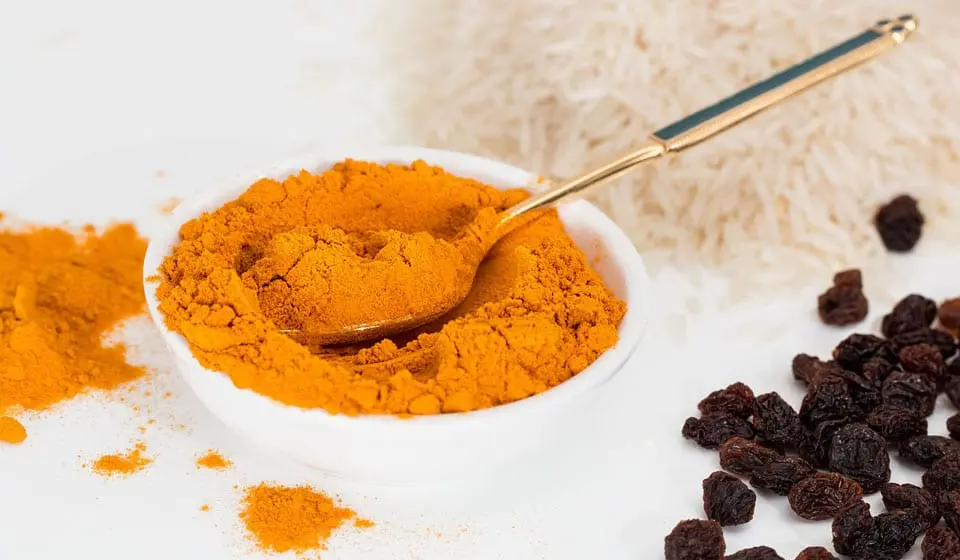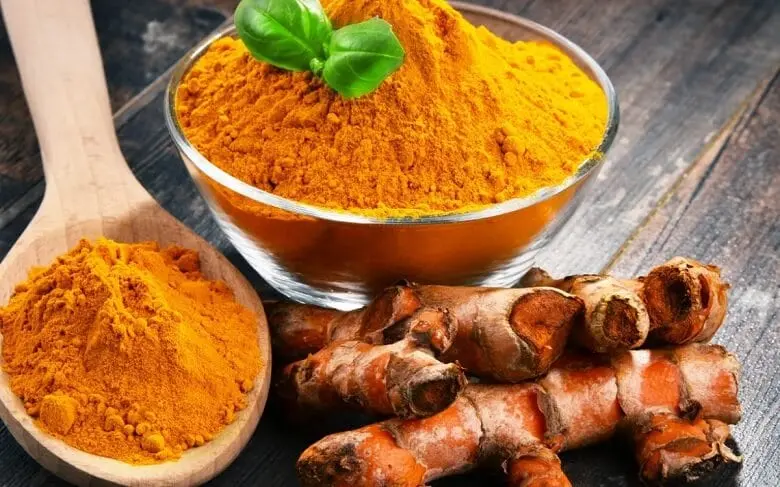Contents
Description
Turmeric is a perennial herb with a yellow root (resembles ginger) up to 90 centimeters high, has oval leaves. In everyday life it is used as a seasoning, medicinal plant and dye.
Turmeric has several proven medicinal properties. With proper consumption of this product, it is possible to significantly improve health. This spice is a natural medicine.
Turmeric history

The historical homeland of turmeric is southeastern India. The root of this plant is the main component of the famous curry seasoning, which not only gives the dish not only a pungent taste and specific aroma, but also a pleasant yellow color.
Even in ancient times, it was noticed that turmeric increases the shelf life of cooked dishes. Gloves, metal and wood were also painted with a plant in a golden color.
Having appreciated all the advantages of turmeric, people began to use it as a cheap substitute for expensive saffron.
Curcumin is still used today in the production of butter, margarine, cheeses, various dishes and medicines.
Turmeric composition

The spice contains a huge amount of antioxidants, which helps to keep the body in good shape and prolong youth. It contains vitamins of groups B, C, E. It has a positive effect on the body with inflammation, pain, and is also a natural antibiotic.
- Caloric content per 100 grams 325 kcal
- Protein 12.7 grams
- Fat 13.8 grams
- Carbohydrates 58, 2 grams
The benefits of turmeric
Turmeric contains essential oils and curcumin (a yellow dye). The plant is rich in phosphorus, iron, iodine, calcium, choline, as well as a group of vitamins B (B1, B2, B5), C and K.
Turmeric removes toxins and harmful substances from the body, as it contains antioxidants that “kill” free radicals.
Scientists believe that the curry spice has a beneficial effect on Alzheimer’s disease, removes excess water from the body, and reduces swelling in arthritis. Turmeric also blocks cancer cells, prevents breast cancer.
The pungent taste of turmeric helps fight viruses and bad bacteria, so the seasoning is useful for all kinds of inflammations. Turmeric normalizes the functioning of the digestive system, kidneys, and gallbladder. Improves appetite.
The harm of turmeric

Overall, turmeric is harmless. The only thing that can be a contraindication to its use is individual intolerance. Therefore, if you are allergic to a hot seasoning, you will most likely have a reaction to turmeric.
Application in medicine
Turmeric promotes the production of bile and gastric juice, therefore it is useful for diseases of the liver, kidneys and gallbladder.
The most valuable thing in turmeric is curcumin. This substance has an antioxidant effect, it fights free radicals. Also protects against cardiovascular diseases and cancer.
There is even research that turmeric is used in the treatment of cancer. In particular, with melanoma and its chemotherapy. She is able to neutralize the harmful effects of chemotherapy. It works great as a natural antibiotic, inhibits the growth of pathogenic flora.
It has anti-inflammatory properties. Turmeric has been shown to inhibit the development of Alzheimer’s disease, multiple sclerosis and senile dementia. The use of this spice affects the work of almost all internal organs. It perfectly cleanses the body of toxins, has a good effect on the liver.
Cooking applications

Curry (Turmeric) is sprinkled with meat dishes, vegetables, fish, soups, omelets and sauces. Turmeric makes the chicken broth rich, removes the bland taste.
In Persian cuisine, turmeric is often used in fried foods.
In Nepal, vegetable dishes are painted with spice.
In South Africa, turmeric is used to give a golden color to white rice and is often added to baked goods and sweet dishes.
British cuisine has borrowed from the Indian use of turmeric – it is added to various hot dishes and sauces.
The most famous turmeric products in Europe are the spicy sweet and sour Piccalilli fruit and vegetable marinade and ready-made mustard.
As for turmeric in cooking in the Asian region, almost all spice mixtures there contain turmeric. In European countries, there are various types of mixtures known as curries, although they are often very distant from their Asian relatives.
Slimming spice

The main active ingredient in the spice is curcumin. It prevents the deposition of adipose tissue and improves metabolism.
Recipe for preparing a turmeric-based slimming product:
- Boil 500 ml of water and add 4 tablespoons of black tea.
- Add 4 pieces of ginger, 2 tablespoons of turmeric, a little honey.
- After cooling, pour in 0.5 liters of kefir.
- Take once a day, morning or evening.
Another option for preparing a means to lose excess weight: take half a glass of boiling water and a glass of unboiled milk for one and a half tablespoons of raw materials. Take the composition before bed.










Is dit waar as jy Norrie gebruik en hulle doen bloed toetse dat die nie die regte uit slae nie